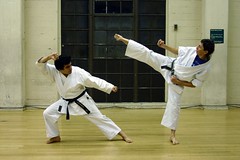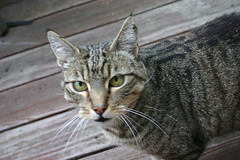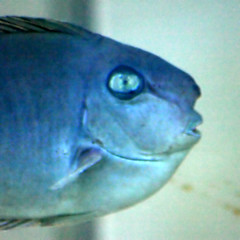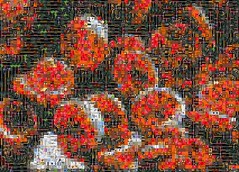End of the Line
This Blog has been moved. For more current entries, see the new location. Thanks.
Making noise, not getting anywhere.

Der Redner steht ein wenig steif am Podium, die Arme eigenartig locker vor dem Bauch verschränkt, und blinzelt nervös ins gedämpfte Licht. Er bewegt sich kaum beim Sprechen, blickt nicht ins Publikum, hat keine Powerpoint-Präsentation vorbereitet. Er spricht frei, mit unbewegtem Gesicht, übers Skifahren, den Geschwindigkeitsweltrekord im Abfahrtslauf von 65 Meilen die Stunde, den er hält, von seiner Frau, die er beim Skifahren traf, während sie vor ihm fuhr und ihm durch Zuruf die Richtung anwies, darüber, wie aufregend es ist, gelb zu sehen. Dabei zeigt er in meine ungefähre Richtung, vor mir sitzt eine Studentin in einem gelben Sweatshirt. Michael May hatte mit drei Jahren einen Unfall, der ihn ein Auge kostete und auf dem anderen erblinden liess - die Hornhaut wurde undurchsichtig. Als er 46 war, drückten ihm die Ärzte der Uniklinik in San Diego einen Stammzellenring und eine neue Hornhaut aufs Auge. Die Operation gelang, und May trat eine Reise durch die Medien an, der wundergeheilte Blinde mit dem Abfahrtsskirekord. Es gibt eine Handvoll anderer solcher Fälle, oft gelang zwar die Operation, aber die folgende radikale Umstellung, der Schimmer Licht - May sieht hauptsächlich Bewegung und Farbe, keine Details - stürzte die meisten Patienten in Depressionen. May führt seinen Erfolg darauf zurück, dass er sich als Blinden versteht, und das zurückgegebene Augenlicht als Zusatz, nicht als etwas, das ihm zuvor gefehlt hätte. Das ausdruckslose Gesicht über die Köpfe des Publikums gewandt, die Augen geschlossen, sagt er: "Seeing is wonderful. But not seeing is also wonderful."

So wie ferne Stürme über dem Pazifik im Beringmeer komplexe Wellenfronten erzeugen, die beim Strandspaziergang mitunter rasche Sprints erforderlich machen, um den plötzlich auflaufenden Riesenwellen trockenen, und vor allem warmen, Fusses zu entgehen, so steigt und fällt unerklärlich der Eichhornpegel rund um den gefallenen Eukalyptusstamm, um den wir füttern. In einem Moment tummeln sich zwölf der Tiere und balgen lautstark um die besten Futterplätze, dann wieder verschwinden sie unerklärlich allesamt minutenlang. Vermutlich machen sie anderswo ihr Hornding, füttern die Brut oder arbeiten an der Übernahme der Weltherrschaft qua Niedlichkeit.
Im Augenblick ist grade wieder Hörnchenebbe, nur noch eins sitzt auf dem Baum und nagt an einer halben Walnuss. Eine mittelalte Japanerin, eine Mutter, die ihre studierende Tochter besucht, nähert sich uns, während die Tochter die Szene aus sicherer Entfernung beobachtet, nestelt an der Digitalkamera und spricht das verbliebene Tier auf Japanisch an, bittet es um ein bisschen Geduld. Das Tier versteht aber kein Japanisch, und ist im selben Moment mit der Nuss fertig und hüpft davon, als die Kamera einsatzbereit ist. Ohh, macht die Japanerin ein wenig enttäuscht, aber schon reiche ich der Fressmaschine eine neue Nuss, und das Foto kann gemacht werden. Thank You, sagt die Japanerin artig, und Do Itashimashite, erwidere ich ebenso artig, keine Ursache, das Sprachenlernen soll ja schliesslich einen Sinn gehabt haben. Die Japanerin verzieht keine Miene, dreht sofort wortlos ab, geht zurück zur Tochter, spricht ein paar Worte, die Tochter blickt in unsere Richtung, dann verschwinden beide. Die Hörnchenflut läuft unterdessen wieder auf, und der Nussausschank floriert.
Sodbrennen kennt ja jeder, hier in den USA zumal. Etliche Regalmeter in den konkurrierenden Drogeriemarktmolochfilialen Walgreens, Long's, Elephant Pharmacy und Walmart sind mit Antacidtabletten, -pasten, -pülverchen vollgestellt, der lustigen Rechtslage im Medikamentenwesen wegen meist mit einem Markenprodukt und der Hauskopie direkt daneben. Die Hauskopie ist von schlichtem Design, ein paar Dollar billiger als die Markenware und fordert den Käufer unweigerlich an prominenter Stelle dazu auf, die Inhaltssangaben mit der des Markenproduktes zu vergleichen. Zeigst du mir deins, zeig ich dir meins. Aber auch ohne diese Produktverdopplung herrscht eine irrwitzige Auswahl and Säurepuffern und -blockern, Kalziumkarbonatkautabletten mit Fruchtgeschmack, Wasserstoffionenpumpenhemmer. Es muss dies ein Aspekt der Freiheit sein, die die Terroristen in solch wilden Aufruhr versetzt.

Seit Wochen bin ich in Sorge, letzte Woche gar ging ich gar nicht erst, und fühlte mich wie ein Drückeberger deshalb, obwohl es auch andere Gründe gab, ich musste eine Programmierarbeit erledigen und hatte grade als der Zeitpunkt naherückte eine schöne Idee, obendrein leitet Mittwochs Judy das Training, und unter ihrer Führung wird selten eine elegante Einheit draus, und oft Ausdauerbelastung bis an die Grenze. Vor allem aber hat Judy Mittwoch vor drei Wochen gefragt, ob ich nicht das Aufwärmen leiten wolle. Schockschwerenot. Ich kniff, und der andere Braungurt musste stattdessen ran, und wurde prompt vom Gastsensei in den Senkel gestellt, wegen angeblich mangelnden Enthusiasmus und nicht ausreichender Führungsqualität. Fünf Minuten Strafpredigt. Seitdem ist mir ein wenig angst und ziemlich bang.
Vor einigen Jahren, die Geschichte erzählte derselbe Gastsensei bei anderer Gelegenheit wie die Kriegsschnurre, die sie ja auch war, waren die Sitten im UC Karateklub noch martialischer, die Disziplin schärfer und kleine pelzige Wesen noch richtige Kampfratten aus dem Abwasserrohr. Damals wurden drei Braungurte ermahnt, sich auf die Übernahme der Aufwärmleitung vorzubereiten. Wer einen Fehler in Abfolge oder Anzahl der Turntanzschritte mache, werde Liegestützen bis zum Ende der normalerweise knapp eine halbe Stunde dauernden Trainings machen. Brian, auf Exempelpirsch, wählte den Braungurt, bei dem er eines Versagens sicher war, und tatsächlich geschah ein Versehen. Leider schon während der ersten Übungen. Für den Übeltäter folgte eine halbe Stunde Liegestütze in der Ecke und, zwei Wochen fiebrige Krankheit und Muskelpein wegen Vollverausgabung. Gute alte Zeit.
Nun steht Judy wieder vor mir und fragt "do you want to lead warmups?" Zwanzig Sekunden lang ringe ich erbärmlich mit mir, "you don't have to" sagt sie, und das gibt den Ausschlag. Wenn ich nicht muss, dann muss ich natürlich, es ist wie bei Kindern und dem Klo, nur ganz anders. Am Ende habe ich mich halbwegs durch die Affäre gerettet, zweimal angehalten und nachgefragt und ungefähr ein Viertel weggelassen. Liegestützen setyt es trotzdem keine. Gepriesen sei der Zivilisationsprozess.

Die Waschmaschine müsste jetzt, daran erinnert mich das penetrante Pfeifen des Herdes, genauer: das penetrante Pfeifen der in den Herd eingebauten Stoppuhr, die Karate-Gis ausreichend durchgewalkt und somit fürs maschinelle Anpusten im Anpuster vorbereitet haben. Ich verlasse daher die Wohnung, die Tür lasse ich keck angelehnt, steige zwo Stockwerke bergab in die kalifornsiche Kälte - es schneite gestern tatsächlich in San Franzisko. Ein Riss quasi im Weltgefüge -, zerre dicken, weissen Baumwollstoff aus der einen Maschine, stopfe ihn in die andere, reihe noch sechs Quarterdollarmünzen in den vorgesehen Schlitzen auf dem Geldeinwurfschlitten auf, schiebe den Schlitten ein (es rastet und rasselt) und drücke den Knopf. Der Anpuster beginnt, die Wäsche im Kreis zu drehen und anzupusten. Ich gehe wieder rauf und schliesse die Tür. Und als ich nun durchs Wohnzimmer gehe, kommt mir jemand entgegen. Das ist sonderbar, weil ich doch alleine zu Hause bin, und unpraktisch, weil die Kampfrüstung jetzt im Anpuster kreist, statt meinen Bierbauch in eine tödliche Kampfmaschine zu kaschieren. Macht aber nichts, denn mir kommt wieder erwarten kein Übeltäter, Gauner oder Halunke entgegen, sondern eine Katze. Also letztlich natürlich doch ein Halunke, aber anders.
Auch das ist sonderbar, denn wir haben ja gar keine Katze, aber wie ich schnell herausfinde sieht die Katze das anders. Vor ein paar Tagen haben wir den Fehler gemacht, auf ihr exzessives Katzengejammer erst mit Reinlassen und dann mit Fisch zu reagieren; jetzt also lässt das Tier sich schon selbst rein, bald wird es dann vermutlich auch die Fischdose selber öffnen. Vorerst geht das aber nicht, denn wir haben keinen Fisch mehr im Haus. Die Katze frass ihn auf. Nach fünf Minuten maunzen und durch die Wohnung paradieren sieht das Tier das dann auch ein und trollt sich. Ist ja grade nochmal gutgegangen.
Die Musik rappelt aus den Ohrkappen, vermutlich sehe ich aus wie ein Idiot damit, aber andererseits wohl kaum mehr als ohne, und dafür aber wie ein besser unterhaltener Idiot. Deal. Zwischen dem Sportgebäude und der Tiefgarage verläuft der Weg, entlang der ich mein frischverputztes Mittagessen nach Hause führe, aber grade jetzt führt er obendrein über gut vier Dutzend Männer und Frauen in Unterhemden, Tarnhosen und Fleckmützen weg. Beziehungsweise natürlich unter ihnen durch. Jedenfalls aber, das muss auch ein mittelalter Bartträger einsehen, der sich mit seinem Dreirad und den Einkäufen in des Dreirades Gepäckkorb mutig in die strammstehende Armee gewagt hat, führt der Weg nicht hindurch. Dreirad und Fahrer sind rettungslos zwischen dem Soldatennachwuchs verkeilt, es geht weder vor noch zurück. In Soldatengesichtern rührt sich kein Muskel. Schlaff hangen Flaggen vom Gestänge. Ich schlängle mich zwischen erstaunlich rundlichen und spannungslosen Leibern hindurch, und trage den Nahrungsball unter meinem Herzen weiter hügelan, als durch das Eelsgeschlängel plötzlich harsches Geschrei dringt. Ich erwürge den Ipod, drehe mich um, und sehe die Exerzizien in zwo Regimenter zerfallen, in Formation und Unterhemd heranjoggen, um dann in Fünfergruppen, unter "One, two, three, four"-Gebell des Fünfergruppeführenden, ins Sportgebäude einzurücken. Oder einzumarschieren, oder was. "Na, sage ich zum Nahrungsball, "da hast Du ja noch was erlebt", gebe dem Ipod einen Reaktivierungsknuff und fahre mit der Verdauung fort.

I post this so others don't have to go through hours of painful hardware research, not because I think it is a particularly interesting story. If you just bought a new, large harddrive which is running inexplicably slow in windows, this story is for you. If you didn't, it's not.
The players in this particular story are a 250GB Seagate drive, a K7AMA ECS motherboard with an ALi chipset on it. The problem is, the harddrive runs extremely slow. And I mean extremely, about 15 times slower than the old, small one it was meant to replace.
Whenever you try to solve a simple hardware problem, like a harddrive running slowly, you invariably learn more about hardware than you wanted to know. You even learn more than your brain is capable of learning. It's a mystery.
In this case, what I learned is that there are numerous operating modes for harddrives under windows. THere are several DMA and Ultra DMA modes, conveniently numbered for easy reference, and something dreadful called PIO. You don't want PIO. But whenever something goes wrong with your harddrive, windows reduces the number of your DMA mode by one, and if enough things have gone wrong, and there are no more DMAs left to take away, to PIO you go. This is pretty much the only thing that comes up on first google searches of the problem, but unfortunately this has nothing to do with the problem. There should be a name for the particular feeling you get when you tracked down a solution for a nasty problem and realize it doesn't work; that quick, thorough switch from elation to dread. I'll call it Metus Repens, because latin sounds cool.
Just for the record: if your drive is ever stuck in PIO because of past errors, uninstalling the IDE channel it's on will probably fix it. Or it might not. Good luck.
But fortunately we're dealing with something else here. Upon booting, the BIOS properly reported the drive as UDMA 5 capable, and S.M.A.R.T., both of which Windows proved W.R.O.N.G.. But there was a small hint indicating that this was not a problem specific to windows. When autodetecting the drive in the BIOS setup, it was identified as a 137GB drive, which is a magical limit for some reason or another. If the BIOS didn't properly recognize the drive, maybe there is some hardware issue windows is struggling with.
So now I did a Google search on K7AMA, PIO and hard drive, and indeed found about a dozen other people stuck with the same problem. There should be a name for that feeling, as well: the realization that your problem is common and does not have a solution. Its about the same feeling people must get when they are told they have an incurable disease. Horror Fatui. I'm not sure that's even proper Latin, but it sounds good, so it'll do.
What it came down to is that the cheapass chipset that ECS chose to put on the K7AMA motherboard does not, when run with its original drivers, like large disks. While both IDE channels should be fully capable of UDMA 5, they actually are not. And since the chipset is cheapass, there are no updated drivers to be found, anywhere. Not on ECS's website, which has everything but the IDE drivers, not on ALi's, which inexplicably doesn't offer any downloads at all, but still has a few references to a drivers section strewn through the pages, all dead links, of course. Bastards.
At that stage I discovered this page, just because I had been searching for hours. Tracking it down again for linking to it just cost me fifteen minutes, in spite the fact that I knew it existed and remembered many keywords and that it was on a .edu server. This site had the ALi integrated IDE driver in a version compatible with my ALi chipset. I don't know where the author got it from, and I don't know why it changed both my IDE channels to SCSI, but I don't care much either, since installing it fixed the speed problems.
I'm glad I got that off my chest. Aren't you, too?
8

Als ich um die Ecke biege, sitzt er da, vielleicht zwei Meter entfernt, und inspiziert einen halbzerkrümelten Keks. Das bindet seine Aufmerksamkeit so sehr, dass ich die Entfernung halbiert habe, ehe er mich bemerkt. "Tenki-wa atsui desu", murmle ich im abwesenden Zwiegespräch mit dem Ipod, dann "Iie, tenki-wa samui desu". Sprachlehrganghohlheiten sind keine Kekse, aber auch ich bin abgelenkt, und erwache erst zum vollen Bewusstsein, als ein erklecklicher Rumms meinen rechten Fuss erschüttert. Augen begegnen sich für eine Sekunde, dann schüttelt er sich und verschwindet in der Hecke. "Kanada-no Tenki-wa warui desu" rufe ich erstaunt aus, und "You fool". Kurz erwäge ich, den Keks zu stehlen, lasse es aber dann doch sein.
Zwei Knoten Wolle, oder wie heißt das, Ball, Bündel, Knäuel. Genau, Knäuel. Zwei wollknäuelgrosse Wollknäuel, was für ein bescheuertes Wort, Knäuel, als würde man auf blind gewordenem Klarplastik rumkauen, zwei Wollknäuel also, eins rot, eins schwarz, trage ich an die riesige Kassentheke. Riesig ist die Theke, weil auf ihr Stoffe aus aller Herren Materialien in Fetzen geschnitten werden können müssen, und nicht, weil meine Wollknäuel findlingsgroß wären. Sie sind eher klein. Trotzdem kommen sie mir vor wie kosmische Leuchtfeuer, genau wie die Stricknadeln in der anderen Hand, ein intensives Signal geht von mir aus, und auf dem Mars hebt ein Ding mit Tentakeln den hässlichen Kopf, zeigt lachend in den Himmel und sagt: "Haha, Kai kauft Strickzeug!". Verloren liegen nun die Knäuel und die Nadeln auf der Riesentheke. Die Handarbeitsverkaufsfrau trägt die Andeutung eines Spottgesichts, glaube ich, es ist schwer zu erkennen, sie ist so weit weg hinter der Riesentheke. "Is there a plan?" fragt sie nach einigen Sekunden Spottgesicht. Irgendwo lacht ein Marsianer.

5
Die Ampel schaltet, als ich beinahe die Kreuzung erreicht habe, und ich bringe das Rad erst in der Mitte des Fussgängerstreifens zum Stehen. Niemand überquert die Strasse hier, ich bleibe also stehen und warte auf die nächste Schaltung. Während des Wartens erinnere ich mich, dass man auch in Kalifornien auch bei Rot rechts abbiegen darf, und ungleich Autos, die die rechte Spur zum gradeausfahren nutzen, kann ich auf meinem Rad dem Nachfolger Platz machen. Der Wagen hinter mir blinkt zwar nicht, aber das tun sie hier ohnehin selten. Ohne abzusteigen ziehe ich also das Rad nach rechts an den Strassenrand, und wirklich rollt sofort das Auto hinter mir voran, ist neben mir, und der Fahrer blafft durchs offene Fenster "I'll roll your piece of shit over if you don't get out of the way", nimmt die Kurve und ist weg.
6
Der Weg von der Universität hügelab ist steil und nagt an den Bremsklötzen. Am rechten Strassenrand stehen die Linienbusse abfahrtbereit und warten auf Studentenfracht. Ich rolle in der Mitte der rechten Spur, einen Meter von der Busaussenseite entfernt, am Bus vorbei, und dann noch ein Stück weiter hügelab, ehe ich an den rechten Strassenrand ausweiche. Ein Mittelklassewagen schiebt sich an mir vorbei, durchs offene Seitenfenster bricht die überschlagende Stimme einer jungen Frau, Beifahrerin, "we'll run you over", vermutlich ist der Satz Teil der Führerscheinprüfung hier.
7
Shattuck teilt sich nördlich des Stadtzentrums von Berkeley, zwei Blocks lang, in zwei separate Einbahnstrassen. Mein Ziel ist das chinesische Restaurant auf der Westseite der Nordspur, ich halte mich also rechts auf der Fahrt nach Norden, grade schnell genug für die Ampelschaltungen, die Autos auf der rechten Spur fahren ein wenig schneller, und stehen je ein paar Sekunden an der noch roten Ampel des nächsten Blocks. Ich drehe mich um, und ein Kleinwagen folgt mir im Abstand von einem Meter. Bremse ich jetzt, falle ich vom Rad, blockiert der Umwerfer die Speichen des Hinterrades, das Auto muss mich überrollen, unmöglich für den Fahrer, schnell genug zu reagieren. Mein Leben für eine halbe Sekunde Zeitersparnis. Immerhin kein aggressiver Ausruf, diesmal.

A neat new study done right here at UC Berkeley finds that when the colours of a target has a different name from that of distracters, the left hemisphere is faster at finding the target than the right, while this advantage disappears for colours without a naming difference. The left hemisphere's edge also disappeared when an additional task taxed verbal working memory, but not when spatial working memory was taxed instead.
So Worf had it right after all, when he said "Sir, I protest - I am not a merry man!". And Whorf was right, as well: language does influence our brain's operations on a very basic level.

On an episode of Whad'ya Know taped in Wyoming I just heard about a man who can place a penny on his tongue, move it up his nose in the back of his throat and retrieve it through the nostrils. Amazing, isn't it? He visited Letterman's show to demonstrate the penny come out of his nose.
That could have been me! I've always been able to put my tongue behind my soft palate and probe my tonsils, but it never occured to me to launch a transportation industry back there. Maybe it's not too late.

The second of the arguments against a materialistic theory of mind that I'm going to debunk is based on an article by Frank Jackson, "What Mary didn't know".
In it, there is a colour scientist, Mary, who has a full materialistic account of colour processing available, she knows everything there is to know about that. But she has lived in a black and white environment all her life. Now Mary is for the first time taken out of that environment and shown something red, the above mosaic of red blood cells, for example. Now, Jackson argues, she knows something she did not know before: she know what it feels like to see something red. Since we have assumed that she had a full materialistic account of colour vision, the quality of seeing is not included in that account. Thus, there is more than said account. QED.
Which, of course, more often than not stands for Quod erit demonstrandum - somthing that should be proven, but isn't.
Let's look at the argument in some detail, to see where it might go wrong. What exactly is it that Mary has learned when she sees the red? Specifically, if we asked her, could she tell us what it is she has learned? Alas, she could not. Anything about the experience of seeing red that she could describe in words - say if the experience suggested warmth to her - would necessarily be part of what she knew before. Remember? She knows everyhting there is to know about colour vision. She knows what happens when coloured light hits the retina, she knows how it tickles the brain, and what associations and processes are caused by it. She would even have known what it felt like to see red - in the theoretical meaning of the words, where she can deduce the causal consequences and side effects of such a feeling.
The only thing she can be said to have gained by being shown the mosaic, is the actual experience. But just as in the case of the bat, where being a bat is not a legitimate part of a theory of the bat's mind, an experience is not something that can or should be part of the theory of mind. The theory should of course describe the experience in all detail and consequence. But it need not, and cannot, contain that experience, nor cause it.
In other words, after looking at the mosaic Mary's brain is in a state it has not been in before, but which she indeed knew everything about beforehand (which in itself is probably impossible, but that's beside the point here).
To require colour vision theory to contain actual brainstates is just as silly as to claim that hydrodynamics is incomplete, because there is no actual physical glass of water in it.

There seems to be a rather curious disconnect between the people doing basic neuroscience research and philosophers of mind. While the former operate on the implicit assumption that mental phenomena are reducible to physical phenomena, and that fully understanding the latter will imply understanding the former, philosophers are struggling with principled objections against this form of materialistic monism.
I recently attended some of John Searle's Philosophy of Mind lectures, where he introduced seven such objections to materialism, including of course his own Chinese Room argument.
On none of the seven did he manage to convince me, and I'll present my counterarguments here. I'll start with the cuddliest of the arguments, put forward by Thomas Nagel, who famously asked
"What is it like to be a bat?"
The argument's core, as I understand it, is: suppose we knew everything knowable about bats. That is a big assumption, and we never might, but even if this were true, Nagel argues, we'd still lack one crucial piece: we wouldn't know what it's lile to be one. Our theories and descriptions of the bat would quantify everything, but they wouldn't capture the quality of batness. This is known as the argument of absent qualia, for obvious reasons, and it seems convincing on the surface - no physical theory about bats can show us what it's like to be one, so being a bat is not part of a physical theory.
This argument is erroneous, and I think it's central problem is a confusion of hierarchies, which I'll explain in a second. But first let's have a look at an analogy. Suppose we knew everything there is to know about water. Would that tell us what it feels like to be wet? Of course it wouldn't, because that is not, indeed cannot be the job of a theory. The theory can describe to us how adhesive and cohesive forces would work to cover our skin with a liquid film, it can tell us how the high specific heat capacity and evaporation will affect skin temperature, how all that combines to create certain nerve impulses, and so on. But to know what it's like, we'll have to jump into a river, or, lacking one, take a shower. Does that mean our theory of water is incomplete? No. All it means is that there is a difference between the theory and the real thing. Real water can be experienced, a theory of real water can't. If there is a hole in a theory at all, it's in the description of our own minds. But let's not worry about that for a moment.
That took us off the bat, so let's get back to it. A theory of the bat's mind will not, indeed cannot, contain a description of what it's like to be a bat, because that isn't even part of the theory of bat minds. It's part of the theory of human minds. We can perfectly describe what goes on inside the bat's mind, relate sensory input to motor output via cognitive processes (if you like that way of describing things, which might turn out not to be too great in the end), without missing a thing.
So back to the description of ourselves. What I indeed can not obtain from the description of a bat is what it would feel like for me to be a bat. But there is two possible arguments against that being a problem. The first one is that is very probably a nonsensical question to ask. I am not a bat, and were I a bat, I wouldn't be me, so it seems pretty close to being logically impossible for me to have the batness cake and feel it, so to speak.
But there is a more profound objection. What is it you want when you ask the above question? You want a theory that, in capturing the structure of the mind, enables you to implement that mind. In other words, you want a theory that produces that which it describes. Which seems even sillier than wanting to be a bat. It's worse than complaining that your theory of water doesn't make you feel wet; it's like complaining that your water theory doesn't make you wet other things, doesn't make you emulate water.
Sounds silly. So why doesn't the bat question sound equally silly? I think it's because of the hierarchy confusion. The practical purpose of theories is to give you an understanding of it's subject. So when the theory is one about mind, and thus about understanding, it seems natural to expect to obtain that understanding that is the subject of the theory, when in fact all the theory is going to give you is an understanding of that understanding.
In short: yes, qualia are absent from the theory. That's because the qualia are not the substance, but the subject of the theory. It's perfectly able to describe them, as much as any theory is able to describe anything. This is different from the real thing, of course, and that's not special to the mind, nor is it a indication that more than the physical world needs describing.
Now go find some nuts. You must be hungry.
Cognitive Daily � Video games: Are the myths true?
Cognitive Daily � The negative impact of positive stereotypes

4a
This ploy is quite popular among marketing fucks, it seems. This is the second one in two weeks I received. Send magazine advertisements that look like an invoice, and some percentage of recipients will be suckered into actually paying and thus subscribing to your quality rag. Why, it's pure evil genius!
A while ago, at an SfN meeting, I attended a ethics panel, where one of the questions discussed was the growing of human neurons in animal brain. Other than being vaguely creeped out by the concept in spite of my better knowledge, I only remember one of the researchers talking about how very, very much they discuss this in the ethics panel at Stanford. I guess he sorta knew that people would be vaguely creeped out.
Now the Frankenmice have made Yahoo News, and no doubt the religious nuts are already collecting their wits for an assault against the perversity of science! So let me be quick to point out that this mousebrained thing is a great idea, for it brings us one step closer to creating Franky and Benjy, the two mouse overlords from The Hitchhikers Guide to the Galaxy.Read more at news.yahoo.com/s/ap/200...
Children Learn by Monkey See, Monkey Do. Chimps Don't. - New York Times
Bees can recognize human faces, study finds
Vielleicht würde es, wenn man mehr davon wüsste, beklommen still werden um dieses Hauptwort "Geist" (Robert Musil, Der Mann ohne Eigenschaften)